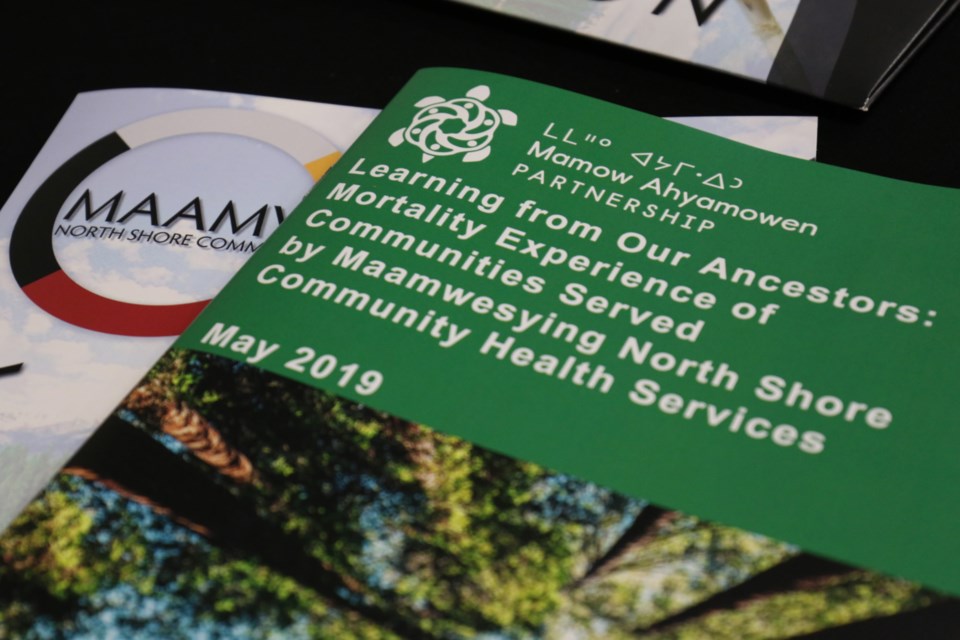Maamwesying North Shore Community Health Services says that more than half of registered members of First Nations along Lake Huron's north shore that are served by the health organization never live to see retirement, and tend to die at younger ages than the rest of Ontario.
That’s just a couple of the findings revealed by the health organization in its report, entitled Learning from Our Ancestors: Mortality Experience of Communities Served by Maamwesying North Shore Community Health Services.
“For many of you, these numbers are just statistics - but for me, they represent family, friends, elders and people I care deeply about,” said Serpent River First Nation Chief Elaine Johnston during the public unveiling of the report, which took place in Batchewana First Nation Thursday.
Johnston says the report - which looks at a host of factors impacting mortality rates in First Nations served by Maamwesying - is the result of two years’ worth of work, using data collected from a number of sources, including Ontario Health Insurance Plan, death certificates and the Indian Registry System between 1992 and 2014.
Some of the findings include:
- 53 per cent of community members die before age 65 compared to 22 per cent for Ontario overall
- Mortality rates due to circulatory deaths are 20 per cent higher (1.2 times higher) than the Ontario average
- Mortality rates due to injuries are 130 per cent higher (2.3 times higher) than the Ontario average.
- Mortality rates due to diabetes are 290 per cent higher (3.9 times higher) than the Ontario average
- 22 per cent of community members have a history of kidney failure, compared to 17 per cent for Ontario as a whole
In all, there were 1,006 deaths among Maamwesying community members between 1992 and 2014, which the health organization says translates into 105 deaths for every 1,000 community members.
“Despite being more likely to die at younger ages, we still find our community members more likely to have a history of diabetes, mental illness including addictions or substance use, kidney failure, heart attacks and rheumatoid arthritis,” Johnston said.
During Thursday’s unveiling of the mortality report, Helen Bobiwash, a member of Thessalon First Nation who works as a consultant in Sudbury, spoke of the human impact of losing family members prematurely.
Her brother, Rodney Bobiwash, was a well-known Indigenous activist and advocate in Toronto before passing away due to complications arising from diabetes in January of 2003.
His 60th birthday would’ve been last week.
“He didn’t have kids, and it was a conscious decision that he made because he felt he didn’t want to pass down his genes and have his children live with diabetes, because he was certain that he would pass it down,” she said, fighting back emotions while speaking.
Given her family history of diabetes, Bobiwash now worries about her 15 year-old son, who is insulin-resistant.
“We live with that illness looming over us,” she said.
Stakeholders in the mortality report are now looking at putting the research document forward to the federal and provincial governments in order to find ways of curbing First Nations mortality rates in Ontario.
Johnston says that partnerships with area hospitals, land-based cultural programming and the implementation of a First Nations health team all could figure into a list of potential solutions.
“We haven’t done an analysis of the dollar figure,” Johnston told reporters following Thursday’s announcement. “We know that we are getting some money from the province and the federal government, but we also know that we’re struggling to maintain or do the work that we’re doing.”
The Maamwesying mortality report is part of a larger study on mortality rates that pooled data from 59 First Nations in northern Ontario, in partnership with nine other regional tribal councils and health organizations.
The report is now available on the Maamwesying North Shore Community Health Services website.
